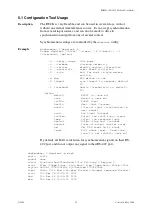
EDM01-14 DAG 3.6D Card User Guide
©2005
32
Version 10: May 2006
6.1 Data Formats
, continued
Table
Table 6- 3 shows the Type 3 ATM Cell Record. The diagram is not to
scale.
timestamp
timestamp
type:3
flags
rlen
lctr
wlen
ATM Header
48 bytes of cell
Table 6-3. Generic Variable Length Record.
The ethernet frame begins immediately after the pad byte so that the layer
3 (IP) header is 32Bit-aligned.
6.2 Timestamps
Description
The ERF format incorporates a hardware generated timestamp of the
packet’s arrival.
The format of this timestamp is a single little-endian 64-bit fixed point
number, representing seconds since midnight on the first of January 1970.
The high 32-bits contain the integer number of seconds, while the lower
32-bits contain the binary fraction of the second. This allows an ultimate
resolution of 2
-32
seconds, or approximately 233 picoseconds.
Another advantage of the ERF timestamp format is that a difference
between two timestamps can be found with a single 64-bit subtraction. It
is not necessary to check for overflows between the two halves of the
structure as is needed when comparing Unix time structures, which are
also available to Windows user in the Winsock library.
Different DAG cards have different actual resolutions. This is
accommodated by the lowermost bits that are not active being set to zero.
In this way the interpretation of the timestamp does not need to change
when higher resolution clock hardware is available.
Continued on next page
Summary of Contents for DAG 3.6D
Page 1: ......
Page 5: ...EDM01 14 DAG 3 6D Card User Guide 2005 ii Version 10 May 2006...
Page 21: ...EDM01 14 DAG 3 6D Card User Guide 2005 16 Version 10 May 2006...
Page 22: ...EDM01 14 DAG 3 6D Card User Guide 2005 17 Version 10 May 2006...
Page 26: ...EDM01 14 DAG 3 6D Card User Guide 2005 21 Version 10 May 2006...
Page 34: ...EDM01 14 DAG 3 6D Card User Guide 2005 29 Version 10 May 2006...


































